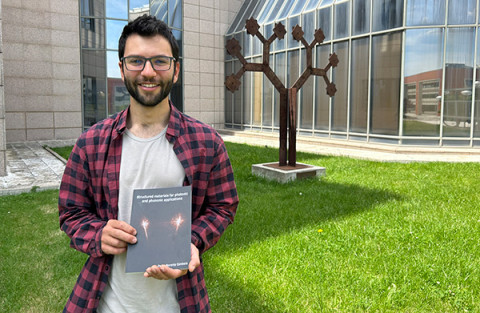Pedro Moronta is defending his thesis: "My research can be applied to sensors, communication technologies, imaging systems, and more"

'Structured materials for photonic and phononic application' is the title of the thesis of Pedro Moronta, who will defend his work next June, 6 at the Facultad de Ciencias. Moronta has been working at the Materials Science Institute of Madrid (ICMM-CSIC) under the supervision of Cefe López, head of the Photonic Crystals Group.
What is the abstract of your work?
Controlling the propagation of waves, such as light and sound, at the nanoscale is essential for advancing photonic and phononic technologies. Two distinct classes of nanostructured materials are investigated: ordered and disordered systems. Self-assembled monolayers of polystyrene nanospheres act as mechanical insulators, exhibiting phononic bandgaps in the gigahertz range. In contrast, disordered structures are explored for their random lasing behaviour. Cavity length, pump conditions, and mode coupling are analysed through theoretical modelling and experimental measurements to understand and control the spectral features of these complex systems. These results provide insights into wave manipulation in nanostructured media, with potential applications in sensing, communication, integrated optomechanical devices and neuromorphic computing.
Why did you choose ICMM for your PhD?
I didn’t know about ICMM until Cefe offered me the opportunity to join the team through an FPI grant. The chance to work on photonics caught my attention and sparked my curiosity, so I decided to take the leap.
How would you explain your research to a non-scientific audience?
I study how tiny structures can control the way light and sound travel through them. By organizing these tiny components in different ways, either in perfect order or in random patterns, we can guide and manipulate waves for useful applications.
What are the main applications of your research? Could you give us an example?
My research can be applied to sensors, communication technologies, imaging systems, and more. For instance, certain structures can block unwanted sound vibrations, which helps protect sensitive components in devices, making them more accurate and stable.
What are the lessons you had learnt here? which one do you value the most?
Beyond the scientific and technical skills, I’ve learned how important it is to take care of ourselves and the people around us. Research can be intense, so learning to find balance and support others has been one of the most valuable lessons.
How do you think this experience will contribute to your training and to your future?
Working in an international and collaborative environment has been incredibly enriching. It’s helped me grow not just as a scientist but also as a person.
What are your plans once you finish your PhD?
I plan to continue working in research. I’m open to exploring new environments and challenges outside ICMM for now—but who knows? I might come back in the future.
Why did you become a scientist? Who have been your role models?
I’ve always been curious about how things work, and I enjoy solving problems. Becoming a scientist felt like a natural way to channel that curiosity. My role models aren’t scientists. They are people who live simply, appreciating life with just what they need.
Instituto de Ciencia de Materiales de Madrid (ICMM)
Sor Juana Ines de la Cruz, 3
Cantoblanco, 28049
Madrid, España
Telephone: (+34) 91 334 90 00
Email: @email
Communication Office: @email

Acknowledge the Severo Ochoa Centres of Excellence program through Grant CEX2024-001445-S/ financiado por MICIU/AEI / 10.13039/501100011033

Contacto | Accesibilidad | Aviso legal | Política de Cookies | Protección de datos